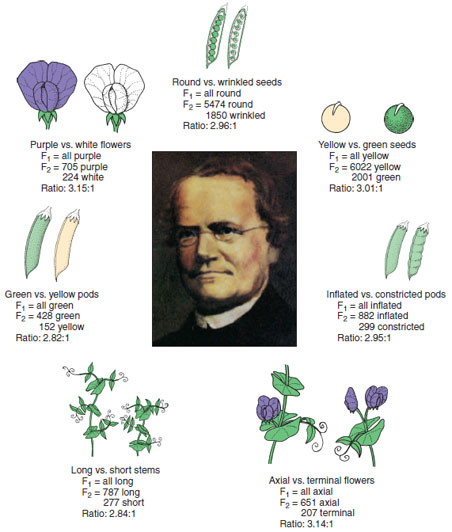Mendel’s Investigations
Mendel’s
Investigations
The first man to formulate the cardinal
principles of heredity was Gregor
Johann Mendel (1822–1884) (Figure 5-1), who was an Augustinian
monk living in Brünn (Brno), Moravia.
At that time Brünn was a part of Austria,
but now it is in the eastern part of
the Czech Republic. While conducting
breeding experiments in a small
monastery garden from 1856 to 1864,
Mendel examined with great care the
progeny of many thousands of plants.
He worked out in elegant simplicity
the laws governing the transmission of
characters from parent to offspring. His
discoveries, published in 1866, were of
great significance, coming just after
Darwin’s publication of The Origin of
Species. Yet these discoveries remained
unappreciated and forgotten until
1900—some 35 years after the completion
of the work and 16 years after
Mendel’s death.
Mendel’s classic observations were based on the garden pea because it had been produced in pure strains by gardeners over a long period of time by careful selection. For example, some varieties were definitely dwarf and others were tall. A second reason for selecting peas was that they were self-fertilizing but also capable of cross-fertilization. To simplify his problem Mendel chose single characters that displayed sharply contrasting traits. He carefully avoided mere quantitative and intermediate characteristics. Mendel selected pairs of contrasting traits, such as tall plants versus dwarf plants and smooth seeds versus wrinkled seeds (Figure 5-1).
A giant stride in chromosomal genetics was made when the great American geneticist Thomas Hunt Morgan and his colleagues selected the fruit fly Drosophila melanogaster for their studies (1910–1920). It was cheaply and easily reared in bottles in the laboratory, fed on a simple medium of bananas and yeast. Most important, it produced a new generation every 10 days, enabling Morgan to proceed at least 25 times more rapidly than with organisms that take a year to mature, such as garden peas. Morgan’s work led to the mapping of genes on chromosomes and founded the discipline of cytogenetics.
Mendel crossed plants having one of these traits with others having the contrasting trait. He removed the stamens (male part, containing the pollen) from a flower to prevent self-fertilization and then placed on the stigma (female part of flower) pollen from the flower of the plant that had the contrasting character. He also prevented the experimental flowers from being pollinated from other sources such as wind and insects. When the cross-fertilized flower bore seeds, he noted the kind of plants (hybrids) that were produced from the planted seeds. Subsequently he crossed these hybrids among themselves to see what would happen.
Mendel knew nothing of the cytological basis of heredity, since chromosomes and genes were unknown to him. Although we can admire Mendel’s power of intellect in his discovery of the principles of inheritance without knowledge of chromosomes, the principles are certainly easier to understand if we first review chromosomal behavior, especially in meiosis.
 |
| Figure 5-1 Seven experiments on which Gregor Mendel based his postulates. These are the results of monohybrid crosses for first and second generations. |
Mendel’s classic observations were based on the garden pea because it had been produced in pure strains by gardeners over a long period of time by careful selection. For example, some varieties were definitely dwarf and others were tall. A second reason for selecting peas was that they were self-fertilizing but also capable of cross-fertilization. To simplify his problem Mendel chose single characters that displayed sharply contrasting traits. He carefully avoided mere quantitative and intermediate characteristics. Mendel selected pairs of contrasting traits, such as tall plants versus dwarf plants and smooth seeds versus wrinkled seeds (Figure 5-1).
A giant stride in chromosomal genetics was made when the great American geneticist Thomas Hunt Morgan and his colleagues selected the fruit fly Drosophila melanogaster for their studies (1910–1920). It was cheaply and easily reared in bottles in the laboratory, fed on a simple medium of bananas and yeast. Most important, it produced a new generation every 10 days, enabling Morgan to proceed at least 25 times more rapidly than with organisms that take a year to mature, such as garden peas. Morgan’s work led to the mapping of genes on chromosomes and founded the discipline of cytogenetics.
Mendel crossed plants having one of these traits with others having the contrasting trait. He removed the stamens (male part, containing the pollen) from a flower to prevent self-fertilization and then placed on the stigma (female part of flower) pollen from the flower of the plant that had the contrasting character. He also prevented the experimental flowers from being pollinated from other sources such as wind and insects. When the cross-fertilized flower bore seeds, he noted the kind of plants (hybrids) that were produced from the planted seeds. Subsequently he crossed these hybrids among themselves to see what would happen.
Mendel knew nothing of the cytological basis of heredity, since chromosomes and genes were unknown to him. Although we can admire Mendel’s power of intellect in his discovery of the principles of inheritance without knowledge of chromosomes, the principles are certainly easier to understand if we first review chromosomal behavior, especially in meiosis.




